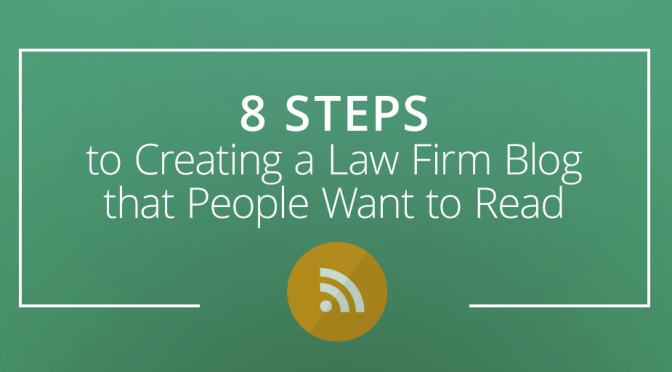Are you subscribed to an email newsletter?
If you’re like most folks, the answer is yes. In fact, you probably have several newsletters sitting in your inbox right now. Some you may find useful, while others are destined for that great “unsubscribe” button in the sky.
So, what makes one newsletter interesting and the other one blah? Why do you read one, and discard the other? You subscribed to every newsletter in your inbox, but some of them are just not worth the click.
We’re not going to allow that to happen to your newsletter. Your newsletter will be worth the click every time, and you’ll earn that distinction by following the tips below.
Since you’re here, I bet you already know the value of an email newsletter. If not, check out this primer: Why You Need an Email List for Your Law Firm & 7 Easy Strategies to Create One. In the above post, I also discussed a few of the very best practices for creating an email newsletter.
Below, let’s expand on some of the ideas introduced in the previous post, and also discuss advanced strategies to take your newsletters from “oh, not them again” to “yay, I love their emails.”
[Tweet “Here are advanced strategies to take your newsletter from “ho-hum” to “hooray!””]
Start with an Email Newsletter Service
I have some good news for you– you don’t have to send email newsletters from your inbox. That would take a lot of time, and it may even get you in hot water with your email provider.
Instead of sending emails from your inbox, you can send them through an email newsletter service provider. There’s plenty to choose from, but I highly recommend MailChimp.
MailChimp is easy to use for complete beginners. It’s free up to 12,000 emails a month and 2,000 users.
MailChimp also integrates beautifully with AmazeLaw.
Because it’s free, easy to use, and works great with sites built by AmazeLaw, I recommend that you start with MailChimp. Setup takes less than five minutes. We’ve actually created a detailed guide to help you through the setup process here.
Don’t forget to create a signup incentive!
Also known as a lead magnet, a signup incentive persuades your website visitors into subscribing to your list. In exchange for their email address, you’ll give away a free gift, generally in digital form (an ebook or a resource guide). But you’re not limited to digital goods. You may also offer something service related, such as a free 10 minute phone consultation.
Would you like more signup incentive ideas? Check out this post: The One Thing You Need to Do to Grow Your Email List.
Have a Purpose for Your Newsletter Other than Updates
Here’s the thing: Boring company updates are just that– boring. Your clients (both current and prospective) aren’t on your list to hear about you. They’re on your list to hear about them, specifically what you can do for them. It’s all about them.
But that doesn’t mean you can’t share information about your law firm. Just remember to present the information in a beneficial way.
For example, introduce the new paralegal on your team by explaining how he or she helps your practice provide better service: “Mindy, our newest paralegal, specializes in real estate law, and brings her extensive knowledge and research skills to our law firm.”
It’s a matter of shifting your perspective (and wording) to engage your readers and make the information relevant to them.
Now, let’s take a look at the different categories of email newsletters.
Newsletters fall into three categories:
Educational
Use your newsletter to answer questions and educate your clients about the law.
Promotional
Use your newsletter to announce upcoming events, advertise new services, and share coupons.
Nurture and Build Trust
Use your newsletter to stay at the top of mind and turn prospects into clients.
Segment Your Newsletter
Segmenting is one of the best things you can do for your newsletter, but if you haven’t heard of it, don’t feel too bad. Most law firms haven’t heard of email segmenting at all, but it’s a proven strategy that will help you create more relevant emails for your subscribers.
Segmenting is when you group people together based on behaviors or demographics.
Let’s say your law firm specializes in family law. You provide services in the areas of child support, divorce, and adoption. Your clientele is varied, and those who sign up to your newsletter will naturally want different things. Some may want ongoing advice about child support, others may want to know the laws surrounding adoption, and others still may want to know what to expect during divorce proceedings.
While there may be some overlap, your audience is likely to need different content. In this case, one size doesn’t fit all.
Enter segmentation.
You can separate each group in your email newsletter service provider and then send relevant emails based on the needs of that group. If there’s a new law that affects adoptions in your state, you may only wish to send a newsletter to the group that’s most interested in adoption.
Start the segmentation process immediately upon signup. You can have a general signup segment for everyone who subscribes on your home page. Then, create another signup segment for those who subscribe on your adoption information page, or your divorce information page.
If you already have an active email list, you can easily send out a survey via email, asking each subscriber what type of content they’d like to receive more of from you in the future. Armed with this information, you can go to your email newsletter service provider and group your subscribers based on each individual answer.
Get to the Point As Quickly As Possible
Email is no place for long, sweeping content. Make your point immediately and then give your audience direction on what to do next.
Ask yourself: What does the subscriber want to get or learn from my emails? Then, set about delivering that type of content every time.
The average email newsletter should be way shorter than the average blog post. Shoot for three paragraphs, maybe four. If that seems too restrictive for you, consider increasing the amount of email newsletters you send out from once every month to twice a month, or even twice a week, if both you and your subscribers are up to it.
This way, you can share more information without forcing your subscribers to read too much at one time (they won’t anyway).
Of course, another option is to segment your subscribers so that you can send each group targeted information without getting too wordy.
Include a Call to Action
A call to action is a simple directive you offer to the reader, telling them what to do next.
Every email newsletter needs a call to action, preferably one that drives subscribers back to your website. Give them a reason to return by teasing the benefit to the subscriber, for example, “Learn more about X on the blog” or “Download this ebook now.”
End each email with a call that gets your subscriber to take the logical next step. It may be obvious to you, but not to them. Spell it out.
Send on a Schedule
Humans like routine– this extends to the humans on your email list. Create a pattern of trust by showing up in their inbox every second Thursday (or whatever schedule you choose).
The last thing you should do is constantly switch up when you send your emails. Sending two email newsletters this month and then waiting six months to send a third is never going to work.
Instead, commit to a schedule that your subscribers can rely on. If you don’t, they’ll quickly forget who you are and may even hit “spam” on you.
Let’s pinky swear on this: set a schedule and stick to it.
Final Thoughts
When a client gives you their email address, it’s quite an honor. It’s also a mark that you’ve already impressed them. All you need to do now is follow the above tips to create a newsletter that clicks with your subscribers.
Oh, don’t forget to check out the Busy Attorney’s Ultimate Guide to Email Marketing. Pair that post with this one and you’ll be email marketing like a pro.






 Google Search: How to pay for an old ticket
Google Search: How to pay for an old ticket Google Search: Do I own my music if it isn’t registered
Google Search: Do I own my music if it isn’t registered

















 Screenshot of Zachar
Screenshot of Zachar  A
A  A Yelp search for “law firms in Phoenix, AZ”
A Yelp search for “law firms in Phoenix, AZ”










